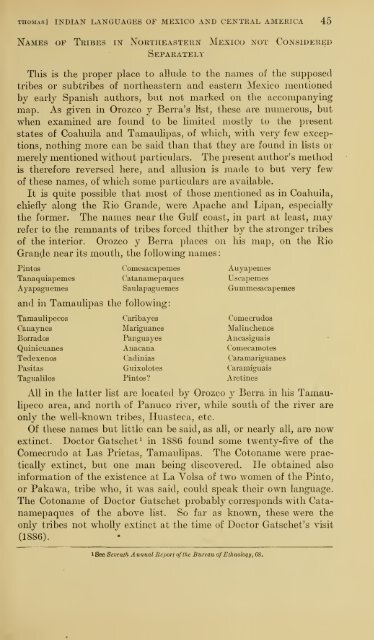Untitled - Smithsonian Institution
Untitled - Smithsonian Institution
Untitled - Smithsonian Institution
Create successful ePaper yourself
Turn your PDF publications into a flip-book with our unique Google optimized e-Paper software.
thomas] indian" languages of mexico and central america 45<br />
Names of Tribes in Northeastern Mexico not Considered<br />
Separately<br />
This is the proper place to alhide to the names of the supposed<br />
tribes or subtribes of northeastern and eastern Mexico mentioned<br />
by early Spanish authors, but not marked on the accompanying<br />
map. As given in Orozco y Berra's list, these are numerous, but<br />
when examined are found to be limited mostly to the present<br />
states of Coahuila and Tamaulipas, of which, with very few excep-<br />
tions, nothing more can be said than that they are found in lists or<br />
merely mentioned without particulars. The present author's method<br />
is therefore reversed here, and allusion is made to but very few<br />
of these names, of which some particulars are available.<br />
It is quite possible that most of those mentioned as in Coahuila,<br />
chiefly along the Rio Grande, were Apache and Lipan, especially<br />
the former. The names near the Gulf coast, in part at least, may<br />
refer to the remnants of tribes forced tliither by the stronger tribes<br />
of the interior. Orozco y Berra places on his map, on the Rio<br />
Grande near its mouth, the following names<br />
Pintos Comesacapemes Auyapemes<br />
Tanaquiapemes Catanamepaques Uscapemes<br />
Ayapaguemes Saiilapaguemes Gummesacapemes<br />
and in Tamauhpas the following:<br />
Tamaulipecos Caribayes Comecrudos<br />
Canaynes Mariguanes Malinchenos<br />
Borrados Panguayes Ancasiguais<br />
Quinicuanes Anacana Comecamotes<br />
Tedexenos Cadinias Caramariguanes<br />
Pasitas Guixolotes Caramiguais<br />
Tagualilos Pintos? Aretines<br />
All in the latter list are located by Orozco y Berra in his Tamau-<br />
lipeco area, and north of Panuco river, while south of the river are<br />
only the well-known tribes, Huasteca, etc.<br />
Of these names but little can be said, as all, or nearly all, are now<br />
'^ extinct. Doctor Gatschet in<br />
1886 found some twenty-five of the<br />
Comecrudo at Las Prietas, Tamaulipas. The Cotoname were prac-<br />
tically extinct, but one man being discovered. He obtained also<br />
information of the existence at La Volsa of two women of the Pinto,<br />
or Pakawa, tribe who, it was said, could speak their own language.<br />
The Cotoname of Doctor Gatschet probably corresponds with Catanamepaques<br />
of the above list. So far as known, these were the<br />
only tribes not wholly extinct at the time of Doctor Gatschet's visit<br />
(1886).<br />
1 See Seventh Annual Report of the Bureau of Ethnology, 68.<br />
:

















